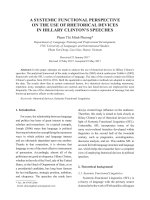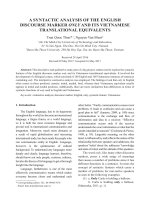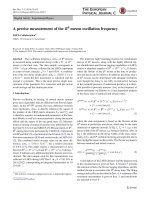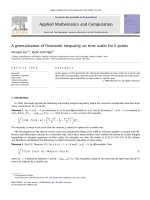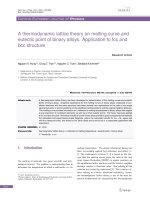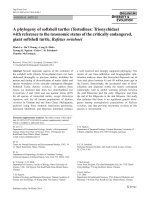DSpace at VNU: A computational study on the adsorption configurations and reactions of SiHx(x=1-4) on clean and H-covered Si(100) surfaces
Bạn đang xem bản rút gọn của tài liệu. Xem và tải ngay bản đầy đủ của tài liệu tại đây (2.94 MB, 34 trang )
Accepted Manuscript
Title: A Computational Study on the Adsorption
Configurations and Reactions of SiHx (x = 1-4) on Clean and
H-covered Si(100) Surfaces
Author: Thong N-M Le P. Raghunath L.K. Huynh M.C. Lin
PII:
DOI:
Reference:
S0169-4332(16)31328-9
/>APSUSC 33469
To appear in:
APSUSC
Received date:
Revised date:
Accepted date:
22-3-2016
25-5-2016
17-6-2016
Please cite this article as: Thong N-M Le, P.Raghunath, L.K.Huynh, M.C.Lin,
A Computational Study on the Adsorption Configurations and Reactions of
SiHx(x = 1-4) on Clean and H-covered Si(100) Surfaces, Applied Surface Science
/>This is a PDF file of an unedited manuscript that has been accepted for publication.
As a service to our customers we are providing this early version of the manuscript.
The manuscript will undergo copyediting, typesetting, and review of the resulting proof
before it is published in its final form. Please note that during the production process
errors may be discovered which could affect the content, and all legal disclaimers that
apply to the journal pertain.
A Computational Study on the Adsorption Configurations and Reactions of
SiHx(x=1-4) on Clean and H-covered Si(100) Surfaces
Thong N-M Le1, P. Raghunath2, L. K. Huynh3* and M. C. Lin2*
1
Molecular Science and Nano-Materials Laboratory, Institute for Computational Science and
Technology, Quang Trung Software Park, Dist. 12, Ho Chi Minh City, Vietnam.
2
Center for Interdisciplinary Molecular Science, Department of Applied Chemistry, National Chiao Tung
University, Hsinchu 300, Taiwan.
3
International University, VNU-HCMC, Quarter 6, Linh Trung, Thu Duc District, Ho Chi Minh City,
Vietnam.
1
Graphical Abstract
2
Highlight
Systematically provides the optimized adsorption configurations of all adsorbates on Si(100)
surface
The mechanisms leading to the formation of silicon adatoms on the surface are proposed
The barriers for hydrogen abstractions from the surface are negligible comparing to the barriers
for the hydrogen migrations
The barriers for hydrogen abstractions from the adsorbed speices are negligible comparing to
the barriers for the decompositions
3
Abstract
Possible adsorption configurations of H and SiHx (x=1-4) on clean and H-covered Si(100) surfaces are
determined by using spin-polarized DFT calculations. The results show that, on the clean surface, the gasphase hydrogen atom and SiH3 radicals effectively adsorb on the top sites, while SiH and SiH2 prefer the
bridge sites of the first layer. Another possibility for SiH is to reside on the hollow sites with a triple-bond
configuration. For a partially H-coverd Si(100) surface, the mechanism is similar but with higher
adsorption energies in most cases. This suggests that the surface species become more stable in the
presence of surface hydrogens. The minimum energy paths for the adsorption/migration and reactions of
H/SiHx species on the surfaces are explored using the climbing image-nudged elastic band method. The
competitive surface processes for Si thin-film formation from SiHx precursors are also predicted. The
study reveals that the migration of hydrogen adatom is unimportant with respect to leaving open surface
sites because of its high barriers (˃ 29.0 kcal/mol). Alternatively, the abstraction of hydrogen adatoms by
H/SiHx radicals is more favorable. Moreover, the removal of hydrogen atoms from adsorbed SiHx, an
essential step for forming Si layers, is dominated by abstraction rather than the decomposition processes.
Keywords: silane precursor, silicon surfaces, Si(100), hydrogen abstractions, plasma enhanced
4
Introduction
Silicon has played an important role in the fabrication of integrated circuits [1]. The advances made
from traditional silicon wafers to silicon thin films make it feasible for a wider range of applications
related to future microelectronic [2] and photovoltaic [3] devices. Plasma-enhanced chemical vapor
deposition (PECVD) [4] is a commonly used technique to grow amorphous [5-8] or crystalline [2, 8-10]
silicon thin films from silane precursors. It has been reported that this technique significantly increased
the growth rate of silicon against thermal depositions (CVD) [6] under identical conditions, although
these processes were controlled by similar surface kinetics [9]. In plasma-enhanced depositions, the
reactive radicals are amplified by collisions of energetic electrons with the precursor molecule such as
SiH4. Co-existing in the gas phase, besides SiH4 (silane), SiH2 (silylene) and silylidyne (SiH), hydrogen
(H) and SiH3 (silyl) are known as the most abundant radicals in this regime [5, 7]. Fast growth rates are
continuously achieved by the adsorption and reactions of the generated radicals with the silicon substrate
surface.
The deposition techniques have evolved in practical applications with large-scale production, but the
key process of silicon thin-film growth has not been fully understood at the molecular level, although the
reactions of SiHx on silicon surfaces have been extensively studied both experimentally [8, 10-12] and
computationally [13-21]. Based on experimental studies, Gate and co-workers [11, 12] proposed the
growth mechanism of silicon which became the preliminary source for a large number of later works. In
these studies, a steady-state surface kinetic model was also developed to estimate the silicon growth rate.
The model provided a rather good description on both mechanism and kinetics for CVD processes. Gate’s
mechanism not only contributed to the understanding of CVD but also PECVD because of their
similarities in surface kinetic occurrences, although PECVD is more complex than CVD in the aspect of
the plasma chemistry producing reactive species for surface reactions to occur. However, the drawback of
this model was to assume the overall growth rate to be equivalent to the dissociative adsorption of SiH4
[12]. Srinivasan [10] showed that hydrogen abstractions and hydrogen etching via Eley-Rideal (ER) [22]
mechanism were important pathways for crystalline silicon formation at temperatures between 25 and 300
5
o
C. In another experiment, Srinivasan [8] found that there was a transition from amorphous silicon to
crystalline silicon by hydrogen abstractions at temperatures lower than 250 oC. Obviously, these
experiments concentrated on abstraction processes for activating adsorption sites on the surface, which
was absolutely necessary in the plasma-enhanced deposition.
On the other hand, computational studies can critically cover various approaches from classical to ab
initio calculations conducted on both cluster and slab models. These calculations, moreover, can extend
over a wide range of surface processes occurring throughout realistic deposition conditions involving
abstractions of surface hydrogens, adsorptions of gas-phase radicals, diffusions of surface radicals,
decompositions of adsorbed species, and abstractions of hydrogens from adsorbed radical species.
Ramalingam et al. [13] showed that there was no energetic difference for hydrogen abstraction by SiH3
from the crystalline or amorphous Si(100)-(2x1) surface. However, the mobility of the radicals was higher
for the amorphous than the crystalline surface. In another work, Ramalingam and co-workers [14]
mentioned that the “valley-filling mechanism” accounts for the surface roughness, i.e., the mobile
precursors such as SiH3 diffuse and react with dangling bonds on the valleys. Cereda [15] estimated the
probability of 60% for the barrierless abstraction of surface hydrogens by silyl radicals via the ER
mechanism. Bakos and coworkers [16] proposed three pathways for H abstraction by SiH3, i.e., ER,
Langmuir-Hinshelwood (LH) [22] and precursor-mediated (PM) [22], where ER was barrierless, while
the barriers for LH and PM models were 17.5-18.0 and 9.0 kcal/mol, respectively. The calculation results
from Kang and Musgrave [17] showed that the barrier for surface hydrogen abstractions was less than 1.0
kcal/mol. As can be seen from the above summary, SiH3 radicals can diffuse on the surface and then
abstract the surface hydrogens via Eley-Rideal mechanism without a significant barrier. When the
dangling bonds are available, further steps are the adsorptions and reactions of radicals on the surface.
The dissociative adsorption of silane was also calculated by Kang and his coworker [17] with a favorable
barrier of 7.4 kcal/mol. This barrier was also found to be 12-14 kcal/mol by Brown and coworkers [18,
19]. Smardon [20] confirmed that silanes adsorbed dissociatively on Si(100)-(2x2); the fragments could
be either on the same dimer or on adjacent dimers with the energy difference of 4.2 kcal/mol. Kang and
6
his coworker [17] determined that the barriers for hydrogen removals from adsorbed SiH3, along with
transforming to SiH2 bridging structure, were 5.7 and 32.9 kcal/mol with and without H(g), respectively.
The full decomposition of SiH3 radicals to Si and H adatoms was also mentioned in Ceriotti’s calculations
[21], which are in good agreement with the experimental data from Gate and coworkers [11]. Overall, the
deposition process extensively incorporates competitive surface processes including diffusions,
abstractions and decompositions. These surface processes should be taken into consideration for
constructing a full thin-film growth mechanism. It has been known that such a growth mechanism
remains unclear. Moreover, the kinetics for most of these processes is not fully characterized
experimentally or computationally.
The purpose of the study is to investigate the mechanisms of the adsorption and decomposition
mechanisms of SiHx(x=1-4) radicals on the Si(100) surface leading to the thin-film growth using the
density functional theory (DFT). The scope of this study includes: (1) hydrogen migrations on the clean
surface, (2) hydrogen abstractions from the surface by either hydrogen atoms or silyl radicals, (3)
decompositions of surface silicon-hydride species, and (4) hydrogen abstractions from the surface siliconhydride species. These surface reactions involve both ER and LH mechanisms that contribute to the thinfilm growth by producing of surface dangling bonds and dehydrogenation of adsorbed species. The
microscopic understanding on the growth mechanism is essential to establish the kinetics as well as to
develop a realistic simulation model which may help predict the evolution of each surface species under
practical conditions. When validated, the mechanism may provide a greater opportunity to effectively
optimize the production of silicon thin films in industrial scales.
Computational methods
All calculations have been carried out using the Vienna Ab initio Simulation Package (VASP) [23-26]
based on periodic density functional theory (DFT). The frozen ionic cores are described by the projector
augmented wave (PAW) method [27], and the Kohn-Sham valence states are expanded in the plane wave
7
basis sets up to 380 eV. The exchange-correlation energy is described by the generalized gradient
approximation with the Perdew-Burke-Ernzerhof (PBE) functional [28-30].
The p(2×2) cell of the Si(100) surface was modeled as periodically repeated slabs with six atomic
layers and four Si atoms on each layer. For the surface calculations, slabs were separated by a vacuum
spacing greater than 17 Å in the direction perpendicular to the surface, which guarantees no interaction
between the slabs. The three top layers were allowed to relax for all geometry optimizations, while the
three bottom layers were fixed at bulk positions with the experimental bulk lattice constant (5.43 Å) [31].
The surface Brillouin zone was sampled with the Monkhorst-Pack scheme [32] using a (6×6×1) k-point
mesh converging with respect to the electronic energy. The ionic relaxation was stopped until the forces
on all free atoms were less than 0.02 eV/Å. The Gaussian smearing method [26, 33] with a smearing
parameter of 0.01 eV was applied. The total energy of all gas-phase species were calculated in a box with
dimensions of 15Å on each side, large enough to ensure negligible interactions between neighboring cells.
Spin-polarized calculations were perfor����������������������������������������������������������������������������������������������������������������������������������������������������������������������������������������������������������������������������������������������������������������������������������������������������������������������������������������������������������������������������������������������������������������������������������������������������������������������������������������������������������������������������������������������������������������������������������������������������������������������������������������������������������������������������������������������������������������������������������������������������������������������������������������������������������������������������������������������������������������������������������������������������������������������������������������������������������������������������������������������������������������������������������������������������������������������������������������������������������������������������������������������������������������������������������������������������������������������������������������������������������������������������������������������������������������������������������������������������������������������������������������������������������������������������������������������������������������������������������������������������������������������������������������������������������������������������������������������������������������������������������������������������������������������������������������������������������������������������������������������������������������������������������������������������������������������������������������������������������������������������������������������������������������������������������������������������������������������������������������������������������������������������������������������������������������������������������������������������������������������������������������������������������������������������������������������������������������������������������������������������������������������������������������������������������������������������������������������������������������������������������������������������������������������������������������������������������������������������������������������������������������������������������������������������������������������������������������������������������������������������������������������������������������������������������������������������������������������������������������������������������������������������������������������������������������������������������������������������������������������������������������������������������������������������������������������������������������������������������������������������������������������������������������������������������������������������������������������������������������������������������������������������������������������������������������������������������������������������������������������������������������������������������������������������������������������������������������������������������������������������������������������������������������������������������������������������������������������������������������������������������������������������������������������������������������������������������������������������������������������������������������������������������������������������������������������������������������������������������������������������������������������������������������������������������������������������������������������������������������������������������������������������������������������������������������������������������������������������������������������������������������������������������������������������������������������������������������������������������������������������������������������������������������������������������������������������������������������������������������������������������������������������������������������������������������������������������������������������������������������������������������������������������������������������������������������������������������������������������������������������������������������������������������������������������������������������������������������������������������������������������������������������������������������������������������������������������������������������������������������������������������������������������������������������������������������������������������������������������������������������������������������������������������������������������������������������������������������������������������������������������������������������������������������������������������������������������������������������������������������������������������������������������������������������������������������������������������������������������������������������������������������������������������������������������������������������������������������������������������������������������������������������������������������������������������������������������������������������������������������������������������������������������������������������������������������������������������������������������������������������������������������������������������������������������������������������������������������������������������������������������������������������������������������������������������������������������������������������������������������������������������������������������������������������������������������������������������������������������������������������������������������������������������������������������������������������������������������������������������������������������������������������������������������������������������������������������������������������������������������������������������������������������������������������������������������������������������������������������������������������������������������������������������������������������������������������������������������������������������������������������������������������������������������������������������������������������������������������������������������������������������������������������������������������������������������������������������������������������������������������������������������������������������������������������������������������������������������������������������������������������������������������������������������������������������������������������������������������������������������������������������������������������������������������������������������������������������������������������������������������������������������������������������������������������������������������������������������������������������������������������������������������������������������������������������������������������������������������������������������������������������������������������������������������������������������������������������������������������������������������������������������������������������������������������������������������������������������������������������������������������������������������������������������������������������������������������������������������������������������������������������������������������������������������������������������������������������������������������������������������������������������������������������������������������������������������������������������������������������������������������������������������������������������������������������������������������������������������������������������������������������������������������������������������������������������������������������������������������������������������������������������������������������������������������������������������������������������������������������������������������������������������������������������������������������������������������������������������������������������������������������������������������������������������������������������������������������������������������������������������������������������������������������������������������������������������������������������������������������������������������������������������������������������������������������������������������������������������������������������������������������������������������������������������������������������������������������������������������������������������������������������������������������������������������������������������������������������������������������������������������������������������������������������������������������������������������������������������������������������������������������������������������������������������������������������������������������������������������������������������������������������������������������������������������������������������������������������������������������������������������������������������������������������������������������������������������������������������������������������������������������������������������������������������������������������������������������������������������������������������������������������������������������������������������������������������������������������������������������������������������������������������������������������������������������������������������������������������������������������������������������������������������������������������������������������������������������������������������������������������������������������������������������������������������������������������������������������������������������������������������������������������������������������������������������������������������������������������������������������������������������������������������������������������������������������������������������������������������������������������������������������������������������������������������������������������������������������������������������������������������������������������������������������������������������������������������������������������������������������������������������������������������������������������������������������������������������������������������������������������������������������������������������������������������������������������������������������������������������������������������������������������������������������������������������������������������������������������������������������������������������������������������������������������������������������������������������������������������������������������������������������������������������������������������������������������������������������������������������������������������������������������������������������������������������������������������������������������������������������������������������������������������������������������������������������������������������������������������������������������������������������������������������������������������������������������������������������������������������������������������������������������������������������������������������������������������������������������������������������������������������������������������������������������������������������������������������������������������������������������������������������������������������������������������������������������������������������������������������������������������������������������������������������������������������������������������������������������������������������������������������������������������������������������������������������������������������������������������������������������������������������������������������������������������������������������������������������������������������������������������������������������������������������������������������������������������������������������������������������������������������������������������������������������������������������������������������������������������������������������������������������������������������������������������������������������������������������������������������������������������������������������������������������������������������������������������������������������������������������������������������������������������������������������������������������������������������������������������������������������������������������������������������������������������������������������������������������������������������������������������������������������������������������������������������������������������������������������������������������������������������������������������������������������������������������������������������������������������������������������������������������������������������������������������������������������������������������������������������������������������������������������������������������������������������������������������������������������������������������������������������������������������������������������������������������������������������������������������������������������������������������������������������������������������������������������������������������������������������������������������������������������������������������������������������������������������������������������������������������������������������������������������������������������������������������������������������������������������������������������������������������������������������������������������������������������������������������������������������������������������������������������������������������������������������������������������������������������������������������������������������������������������������������������������������������������������������������������������������������������������������������������������������������������������������������������������������������������������������������������������������������������������������������������������������������������������������������������������������������������������������������������������������������������������������������������������������������������������������������������������������������������������������������������������������������������������������������������������������������������������������������������������������������������������������������������������������������������������������������������������������������������������������������������������������������������������������������������������������������������������������������������������������������������������������������������������������������������������������������������������������������������������������������������������������������������������������������������������������������������������������������������������������������������������������������������������������������������������������������������������������������������������������������������������������������������������������������������������������������������������������������������������������������������������������������������������������������������������������������������������������������������������������������������������������������������������������������������������������������������������������������������������������������������������������������������������������������������������������������������������������������������������������������������������������������������������������������������������������������������������������������������������������������������������������������������������������������������������������������������������������������������������������������������������������������������������������������������������������������������������������������������������������������������������������������������������������������������������������������������������������������������������������������������������������������������������������������������������������������������������������������������������������������������������������������������������������������������������������������������������������������������������������������������������������face hydrogens plays a critical role in promoting the growth rate of thin films by
providing reactive surface dangling bonds [8, 10, 15]. The reaction may occur through Eley-Rideal
mechanism by which the reactive gas-phase radicals abstract adsorbed hydrogens from the surface and
create adsorption sites with dangling bonds. In our present study, H and SiH3 were found to successfully
abstract the surface hydrogens to release H2 and SiH4 gases, respectively, without well-defined in
transition barriers.The SiH radical was found to form an unstable complex on the surface, while the SiH2
was found to directly insert into a surface Si-H bond to form adsorbed SiH3. The H and SiH3 abstraction
18
reactions are described as (1) H(g) + H(a) → H2(g) + db, and (2) SiH3(g) + H(a) → SiH4(g) + db,
respectively, where db means a dangling bond. The plots of instrinsic reaction coordinates along the
reaction path of these abstractions are showed in Figure 5 and Figure 6. As can be seen from the reaction
path figures, there are zero barriers for the hydrogen abstractions by H and SiH3 regardless of the
coverages of surface hydrogens. This findings is in good agreement with the conclusions from Cereda et
al. [15], Bakos and coworkers [16], while Kang’s results [17] showed that the barrier was less than 1.0
kcal/mol for silane formation.
19
RC = 0.0
RC = 0.4
RC = 0.9
RC = 0.0
(a)
RC = 0.3
RC = 0.9
(b)
Figure 5. Minimum energy path for the abstraction of surface hydrogens by H atom, (a) single H-covered
and (b) full H-covered regime. In both figures, the reaction coordinates of 0.0 and 0.9 correspond to the
initial state involving H atom 3.75 Å away from the surface and the final state involving H2 molecule 3.0 Å
away from the surface, respectively. The reaction coordinates of 0.4 in (a) and 0.3 in (b) involve H2
molecule 2.34 and 2.0 Å away from the surface, respectively. RC denotes “ Reaction Coordinate”.
RC = 0.0
RC = 0.3
RC = 0.9
RC = 0.0
RC = 0.2
RC = 0.5
(a)
(b)
Figure 6. Minimum energy path for the abstractions of surface hydrogens by SiH3 radical, (a) single
hydrogen-covered and (b) full hydrogen-covered regime. In (a), the reaction coordinates of 0.0 and 0.3
20
correspond to the SiH3 radical 3.7 and 4.2 Å away from the surface, respectively; while the reaction
coordinate of 0.9 represents the SiH4 molecule 4.0 Å away from the surface. In (b), the reaction
coordinates of 0.0 and 0.2 correspond to the SiH3 radical 4.34 and 3.75 Å away from the surface,
respectively; while the reaction coordinate of 0.5 represents the SiH4 molecule 5.33 Å away from the
surface. These distances are set to be far enough to guarantee the fact that they are coming from and
leaving to infinity. RC denotes “Reaction Coordinate”.
The insertion of SiH2 radical into the surface Si-H may be described as, SiH2(g) + H(a) → SiH3(a).
This reaction should be taken into consideration because it can contribute to the formation of surface
silyls, increasing the probability for further reactions and the formation of the silicon layers. Among the
reactive radicals, in the full hydrogen-covered regime, the reactions of SiH radicals are less important
with respect to the hydrogen abstractions because of forming unstable complexes on the surface instead.
To the best of our knowledge, the role of SiH and SiH2 gas-phase radicals in hydrogen abstractions has
not been evaluated in previous studies.
c) Decompositions of SiHX on clean Si(100)-2x2 surface
SiH4 decomposition
The progressive decomposition process of SiH4 can be described as, SiH4(g) + db → SiH4(p) →
H3Si,H(a) → H2Si,2H(a); the potential energy profile is shown in the Figure 7. In the physisorbed state
(cf. Figure 3, sih4-si-t1), SiH4(p), the hydrogen in the silane forms a weak bond to the surface silicon with
the adsorption energy of 2.6 kcal/mol and the H(silane)-Si(s) bond length of 1.9 Å; this value is a little
longer than the typical bond length of 1.5 Å between the adsorbed H and surface silicon. The evolution
path of silane critically depends on its orientation on the surface. From this physisorbed state, the
decomposition process undergoes with a rather small energy barrier of 5.4 kcal/mol (TS1) to give
adsorbed SiH3 and H fragment on the same dimer (intra-dimer decomposition). This barrier may be
compared with 7.4 kcal/mol result by Kang and Musgrave [17] based on the cluster model with the
B3LYP method which is higher than the experimental values varying from 3.3 to 4.0 kcal/mol [17].
Accordingly, the CI-NEB method only overestimates the barrier by about 1~2 kcal/mol. The adsorbed
SiH3 continues passing through an exceedingly high barrier of 31.1 kcal/mol (TS2) in order to break its
21
hydrogen and form a double-bond bridging to the adjacent dimer simultaneously, as shown in Figure 7.
There are two other channels for SiH4(p) decomposition with the higher barriers, i.e., 12.4 and 14.4 [17]
kcal/mol for the intra-dimer decomposition, resulting from the sih4-si-t2 configuration (cf. Figure 3), and
the inter-dimer decomposition, producing SiH3 and H fragments on the two nearest sites of the adjacent
dimers, respectively. Because of high energy barriers compared to the sih4-si-t1 decomposition, the full
decomposition pathways initiating from these channels are not considered in this study.
Figure 7. Potential energy surface for the decomposition of SiH4(g) to SiH2(a) on Si(100)-2x2 clean
surface. The reference state is the clean surface and SiH4 gas-phase. The energy barriers for TS1 and TS2
are 5.4 and 31.1 kcal/mol, respectively. The grey and white spheres are Si and H atoms, respectively.
SiH3 decomposition
It was shown in the experiments from Gates and coworkers [11] that SiH3 readily decomposes to SiH2 and
H fragments at the temperature range from 200 to 600 K. Based on this experimental result, in our
calculation, we propose the two pathways for SiH3 decomposition denoted by _b1 and_b2,
SiH3(g) → SiH3(a) → H2Si_b1,H(a) → HSi_b1,2H(a)
(_b1)
→ H2Si_b2,H(a) → HSi_b2,2H(a)
(_b2)
22
The radical SiH3 adsorbs on the top site of the surface silicon forming a new Si-Si bond. From this
configuration, one of the H-atom of SiH3(a) can migrate to the opposite site of the adjacent dimer, leaving
two possibilities for the adsorbed SiH2 to reconstruct to lower energy states. It may form a bridge bond
with the silicon on the same dimer (intra-dimer bridging) or form a bridge-bond with the nearest silicon
on a neighboring dimer (inter-row bridging). Figure 8 plots the two different pathways for SiH3 sequential
decomposition on the silicon surface with the grey line for intra-dimer bridging (uper configurations, _b1)
and the black line for inter-dimer bridging (lower configurations, _b2). Although the local minima along
the intra-dimer path producing SiH2(a) and SiH(a) are energetically slightly less favored comparing to the
inter-dimer path, their barriers to these products are slightly lower, 24.1 (TS3) vs 29.0 (TS4) kcal/mol for
SiH3 decomposition, and 17.5 (TS5) vs 22.1 (TS6) kcal/mol for SiH2 decomposition. After the formation
of SiH adsorbed species, there are no neighboring dangling bonds available for SiH decomposition to
give a Si adatom, whose formation will depend on the ER-type H-abstraction reactions.
Figure 8. Potential energy surface for SiH3(a) sequential decomposition to HSi_b1 and HSi_b2 on Si(100)2x2 clean surface. The energy barriers passing through TS3 and TS4 are 24.1 and 29.0 kcal/mol,
23
respectively. While the energy barriers for TS5 and TS6 are 17.5 and 22.1 kcal/mol, respectively. The
grey and white spheres are Si and H atoms, respectively.
SiH2 decomposition
SiH2(g) → H2Si_b1(a) → HSi_b1,H(a) → Si_b1,2H(a)
(channel 1)
→ H2Si_b2(a) → HSi_b2,H(a) → Si_b2,2H(a)
(channel 2)
For the reactions of SiH2 on silicon surfaces, Gate et al. [11] have provided a reasonable mechanism
for the reactions. At high surface coverage, SiH2(a) can diffuse and recombine to form HSi-SiH(a) +
H2(g). But at low surface coverage, SiH2(a) directly decomposes to SiH(a) + H(a). Figure 9 shows the
most stable adsorption configurations leading to the two dissociative channels on the clean silicon
surface. In channel 1, the bridged adsorbate on the same dimer, H2Si_b1(a) can overcome a moderate
transition state TS7 with a 19.4 kcal/mol barrier producing SiH(a) + H(a), denoted as HSi_b1,H(a). The
intermediate adsorbate HSi_b1,H(a) continuely decomposes via TS8 with a rather low barrier of 8.3
kcal/mol, produccing Si(a) + 2H(a), denoted as Si_b1,2H(a). In the other channel, starting from the
bridged adsorbate across the dimers, H2Si_b2(a) can dissociate via TS9 with a similar 19.8 kcal/mol
barrier, giving HSi_b2,H(a). This adsorbate progressively dissociates via TS10 with 20.4 kcal/mol barrier
to form Si(a) + 2H(a), denoted as Si_b2,2H(a). Noticeably, the two paths are very similar except for the
decomposition via TS8 in channel 1. The lowest energy barrier in this step suggests that the
decomposition of SiH2(a) to Si(a) preferably occurs with the bridged adsorbate on the same dimer rather
than the across dimer process.
24
Figure 9. Potential energy surface for SiH2(g) sequential decompositions to Si_b1,2H(a) (channel 1, left
direction) and Si_b2,2H(a) (channel 2, right direction) on Si(100)-2x2 clean surface. The energy barriers
passing through TS7, TS8, TS9 and TS10 are 19.4, 8.3, 19.8 and 20.4 kcal/mol, respectively. The grey
and white spheres are Si and H atoms, respectively.
SiH decomposition
SiH(g) → HSi_b1(a) → Si_b1,H(a)
(channel 1)
→ HSi_b2(a) → Si_b2,H(a)
(channel 2)
The decompositions of SiH species to Si adatoms are primary reaction steps for the surface growth.
Figure 10 shows the potential energy surface for SiH(g) decompositions on the clean Si(100)-2x2 surface
following the two different channels. Channel 1, HSi_b1(a) → Si_b1,H(a), is the hydrogen elimination
from SiH_b1, the intra-dimer bridging species. The other channel, HSi_b2(a) → Si_b2,H(a), proceeds by
the hydrogen elimination from SiH_b2, the inter-dimer bridging species. The calculated energy barrier
from channel 1 (via TS11) is much lower than the barrier from channel 2 (via TS12), i.e., 10.7 vs 20.7
kcal/mol, respectively. The intra-dimer decomposition is therefore kinetically favored over the interdimer process during the formation of Si-surface from the adsorbed SiH species.
25
Figure 10. Potential energy surface for SiH(g) sequential decompositions to Si_b1,H(a) (channel 1, left
direction) and Si_b2,H(a) (channel 2, right direction) on Si(100)-2x2 clean surface. The energy barriers
passing through TS11 and TS12 are 10.7 and 20.7 kcal/mol, respectively. The grey and white spheres are
Si and H atoms, respectively.
d ) Abstraction of hydrogens from SiHx adsorbed species
The abstraction of H atoms from surface silicon-hydride species by gas-phase hydrogen atoms plays a
critical role in the formation of crystalline silicon [8, 10, 48]. Experimental studies [8, 10], by analyzing
infrared, Raman and mass spectroscopy, confirmed that there was a reduction in SiH content from the
surface and a transition from amorphous silicon to crystalline silicon by hydrogen abstractions; the result
of cluster model calculations [48] provided the barriers for these abstraction processes. In an attempt to
validate the previous studies and further evaluate the kinetic contributions between the abstraction and
decomposition processes, we have employed both the CI-NEB and cluster methods to estimate the barrier
heights for various abstraction reactions from surface silicon hydrides.
The general form for hydrogen abstractions from SiHx can be described as, H(g) + SiHx(a) → H2(g) +
SiHx-1(a) (x= 1, 2, 3). The calculated results show that these abstraction reactions are barrierless. A clear
view of the reaction channels and the comparison between the decomposition and abstraction can be
found in Figure 11, Figure 12 and Figure 13, which are corresponding to SiH3, SiH2 and SiH processes,
respectively. Regarding to the formation of Si adatoms on the surface, Figure 13 plot the energy profiles
26
for the abstractions of H from (a) the intra-dimer, HSi_b1 and (b) the inter-dimer, HSi_b2, in comparison
to the decompositions, respectively. As can be seen, there are no barriers for the two channels of the H
abstraction from adsorbed SiH, whereas the decompositions from the intra-dimer bridging and the interdimer bridging undergo moderate energy barriers of 10.7 and 20.7 kcal/mol, respectively. Our results can
be compared with Srinivasan and Parsons’ observations [8] that predicted a small activation barrier of 5
kcal/mol for this abstraction. Additionally, in their another work using atomic deuterium for the same
abstraction [10], this activation barrier is nearly close to zero. Whereas, the cluster calculations from
Srinivasan et al. [48] reported a 5.5 kcal/mol for that abstraction. Generally, H abstraction from adsorbed
SiH undergoes a small energy barrier, which is zero based on our calculations. This result implies that the
formation of Si adatom during the deposition process is mainly arises from the H-abstraction instead of
the decomposition of SiH adsorbed species.
27
Figure 11. Energy path comparison between decomposition and H abstraction from surface SiH3. The
solid lines with +H(g) symbol represents the abstraction channel, one H atom from the gas phase
eliminates one H from the surface SiH3 to produce H2(g). The dash line with TS is the decomposition
channel. The zero-energy levels are chosen to be the initial states on each channel. They are SiH3(a) and
SiH3(a) + H(g) for the decomposition and abstraction channel, respectively.
(a)
(b)
Figure 12. Energy path comparison between decomposition and H abstraction from surface SiH2
involving the two-most stable configurations, (a) intra-dimer bridging, H2Si_b1 and (b) inter-dimer
bridging, H2Si_b2. The solid lines with +H(g) symbol represent the abstraction channels, one H atom
from the gas phase eliminates one H from the surface SiH2 to produce H2(g). The dash lines with TS are
the decomposition channels. For both mechanisms in (a) and (b), the zero-energy levels are chosen to be
the initial states on each reaction channel. For (a), they are H2Si_b1(a) and H2Si_b1(a) + H(g) for the
decomposition and abstraction channel, respectively. It is similar in (b).
28
(a)
(b)
Figure 13. Energy path comparision between decomposition and H abstraction from surface SiH
involving the two-most stable configurations, (a) intra-dimer bridging and (b) inter-dimer bridging. The
solid lines with +H(g) symbol represents the abstraction channels, one H atom from the gas phase
eliminates one H from the surface SiH to produce H2(g). The dash lines with TS are the decomposition
channels. For both mechanisms in (a) and (b), the zero-energy levels are chosen to be the initial states on
each reaction channel. For (a), they are HSi_b1(a) and HSi_b1(a) + H(g) for the decomposition and
abstraction channel, respectively. It is similar in (b).
Conclusions
In summary, the DFT method has been employed to investigate the surface processes for the silicon
thin-film growth. The most stable adsorption configurations are provided from which surface reactions
may favorably occur. The barrier for the dissociative chemisorption of silane is estimated to be 5.4
kcal/mol, which is comparable to the value of 7.4 kcal/mol from Kang and Musgrave [17]. The SiH3
radicals prefer the top adsorption sites, from there sequentially decomposition reactions losing its
hydrogens first giving rise to bridged SiH2 and then SiH, following two distinctive reaction paths with the
energy barrier difference by at least 5 kcal/mol. Although the gas-phase SiH2 radicals favorably adsorb on
bridge sites with the same fashion as the SiH2 decomposing from SiH3, further decomposition reactions of
adsorbed SiH2 are energetically and kinetically similar for both channels. Hydrogen migrations were
found to be insignificant factors in providing surface dangling bonds because of their rather high barriers,
ranging from 29.0 to 45.0 kcal/mol. In contrast, abstractions of surface hydrogens were found to occur
without energy barriers; they are more favorable in providing adsorption sites, in accordance with the
previous conclusions [15-17]. Additionally, the barrierless abstractions from adspecies by H atoms and
29
SiHx radicals, comparing to the barrier energies ranging from 8 to 31 kcal/mol for their decomposition
reactions, suggest that it is kinetically more favorable for hydrogen abstractions from adsorbed species for
the growth of Si-Si bonds under the PECVD conditions.
Acknowledgements
This research was funded by the Department of Science and Technology - Ho Chi Minh City,
Vietnam to the Institute for Computational Science and Technology (ICST) at Ho Chi Minh City
(contract no. 172/2015/HĐ-SKHCN) and the Ministry of Science and Technology to the Center for
Interdisciplinary Molecular Science, Department of Applied Chemistry, National Chiao Tung University.
P.R. gratefully acknowledges financial support for this study from the Ministry of Science and
Technology, Taiwan under contract MOST 103-2113-M-009-011-MY2. The authors are grateful to the
National Center for High-performance Computing, Hsinchu Science Park, Hsinchu City, Taiwan for
computing resources. This work has also been benefited in the computer time and facility from the ICST
and International University, VNU-HCMC.
30
References
[1] G.E. Moore, The role of Fairchild in silicon technology in the early days of "Silicon Valley",
Proceedings of the IEEE, 86 (1998) 53-62.
[2] N. Yamauchi, R. Reif, Polycrystalline silicon thin films processed with silicon ion implantation and
subsequent solid‐phase crystallization: Theory, experiments, and thin-film transistor applications,
Journal of Applied Physics, 75 (1994) 3235-3257.
[3] A. Shah, P. Torres, R. Tscharner, N. Wyrsch, H. Keppner, Photovoltaic Technology: The Case for
Thin-Film Solar Cells, Science, 285 (1999) 692-698.
[4] T.J. Donahue, R. Reif, Silicon epitaxy at 650-800 °C using low‐pressure chemical vapor deposition
both with and without plasma enhancement, Journal of Applied Physics, 57 (1985) 2757-2765.
[5] M. Moravej, S.E. Babayan, GRNowling, X. Yang, R.F. Hicks, Plasma enhanced chemical vapour
deposition of hydrogenated amorphous silicon at atmospheric pressure, Plasma Sources Sci.
Technol., 13 (2004) 8-14.
[6] H. Wiesmann, A.K. Ghosh, T. McMahon, M. Strongin, a‐Si : H produced by high‐temperature
thermal decomposition of silane, Journal of Applied Physics, 50 (1979) 3752-3754.
[7] A. Gallagher, Neutral radical deposition from silane discharges, Journal of Applied Physics, 63 (1988)
2406-2413.
[8] E. Srinivasan, G.N. Parsons, Hydrogen elimination and phase transitions in pulsed-gas plasma
deposition of amorphous and microcrystalline silicon, Journal of Applied Physics, 81 (1997) 28472855.
[9] J.H. Comfort, R. Reif, Plasma‐enhanced deposition of high‐quality epitaxial silicon at low
temperatures, Applied Physics Letters, 51 (1987) 2016-2018.
[10] E. Srinivasan, G.N. Parsons, Hydrogen abstraction kinetics and crystallization in low temperature
plasma deposition of silicon, Applied Physics Letters, 72 (1998) 456-458.
[11] S.M. Gates, C.M. Greenlief, D.B. Beach, Decomposition mechanisms of SiHx species on Si(100)‐
(2×1) for x=2, 3, and 4, The Journal of Chemical Physics, 93 (1990) 7493-7503.
[12] S.M. Gates, S.K. Kulkarni, Kinetics of surface reactions in very low‐pressure chemical vapor
deposition of Si from SiH4, Applied Physics Letters, 58 (1991) 2963-2965.
[13] S. Ramalingam, D. Maroudas, E.S. Aydil, Atomistic simulation study of the interactions of SiH3
radicals with silicon surfaces, Journal of Applied Physics, 86 (1999) 2872-2888.
[14] S. Ramalingam, S. Sriraman, E.S. Aydil, D. Maroudas, Evolution of structure, morphology, and
reactivity of hydrogenated amorphous silicon film surfaces grown by molecular-dynamics
simulation, Applied Physics Letters, 78 (2001) 2685-2687.
[15] S. Cereda, M. Ceriotti, F. Montalenti, M. Bernasconi, L. Miglio, Quantitative estimate of H
abstraction by thermal SiH3 on hydrogenated Si(001)(2×1), Physical Review B, 75 (2007) 235311-1
– 235311-8.
[16] T. Bakos, M.S. Valipa, D. Maroudas, Thermally activated mechanisms of hydrogen abstraction by
growth precursors during plasma deposition of silicon thin films, The Journal of Chemical Physics,
122 (2005) 054703-1 – 054703-9.
[17] J. Ku Kang, C.B. Musgrave, Theoretical study of the chemical vapor deposition of (100) silicon from
silane, Physical Review B, 64 (2001) 245330-1 – 245330-11.
[18] A.R. Brown, D.J. Doren, Dissociative adsorption of silane on the Si(100)-(2×1) surface, The Journal
of Chemical Physics, 110 (1999) 2643-2651.
[19] A. Robinson Brown, D.J. Doren, Energetics of silicon hydrides on the Si(100)-(2×1) surface, The
Journal of Chemical Physics, 109 (1998) 2442-2449.
[20] R.D. Smardon, G.P. Srivastava, Ab initio surface reaction energetics of SiH4 and Si2H6 on Si(001)(2×2), The Journal of Chemical Physics, 123 (2005) 174703-1 – 104703-8.
31
[21] M. Ceriotti, S. Cereda, F. Montalenti, L. Miglio, M. Bernasconi, Ab initiostudy of the diffusion and
decomposition pathways of SiHx species on Si(100), Physical Review B, 79 (2009) 165437-1 –
165437-13.
[22] R.I. Masel, Introduction to surface reactions, in: Principles of adsorption and reaction on solid
surfaces, Wiley, New York, 1996, pp. 445.
[23] G. Kresse, J. Hafner, Ab initio molecular dynamics for liquid metals, Physical Review B, 47 (1993)
558-561.
[24] G. Kresse, J. Hafner, Ab initio molecular-dynamics simulation of the liquid-metal–amorphoussemiconductor transition in germanium, Physical Review B, 49 (1994) 14251-14269.
[25] G. Kresse, J. Furthmüller, Efficient iterative schemes for ab initio total-energy calculations using a
plane-wave basis set, Physical Review B, 54 (1996) 11169-11186.
[26] G. Kresse, J. Furthmüller, Efficiency of ab-initio total energy calculations for metals and
semiconductors using a plane-wave basis set, Computational Materials Science, 6 (1996) 15-50.
[27] P.E. Blöchl, Projector augmented-wave method, Physical Review B, 50 (1994) 17953-17979.
[28] J.P. Perdew, J.A. Chevary, S.H. Vosko, K.A. Jackson, M.R. Pederson, D.J. Singh, C. Fiolhais,
Atoms, molecules, solids, and surfaces: Applications of the generalized gradient approximation for
exchange and correlation, Physical Review B, 46 (1992) 6671-6687.
[29] J.P. Perdew, K. Burke, M. Ernzerhof, Generalized Gradient Approximation Made Simple, Physical
Review Letters, 77 (1996) 3865-3868.
[30] J.P. Perdew, K. Burke, M. Ernzerhof, Perdew, Burke, and Ernzerhof Reply, Physical Review Letters,
80 (1998) 891-891.
[31] Y. Okada, Y. Tokumaru, Precise determination of lattice parameter and thermal expansion
coefficient of silicon between 300 and 1500 K, Journal of Applied Physics, 56 (1984) 314-320.
[32] H.J. Monkhorst, J.D. Pack, Special points for Brillouin-zone integrations, Physical Review B, 13
(1976) 5188-5192.
[33] C.L. Fu, K.M. Ho, First-principles calculation of the equilibrium ground-state properties of transition
metals: Applications to Nb and Mo, Physical Review B, 28 (1983) 5480-5486.
[34] G. Henkelman, B.P. Uberuaga, H. Jónsson, A climbing image nudged elastic band method for
finding saddle points and minimum energy paths, The Journal of Chemical Physics, 113 (2000)
9901-9904.
[35] K.P. Huber, G. Herzberg, Molecular spectra and molecular structure. IV. Constants of diatomic
molecules, Van Nostrand Reinhold Co, 1979, 1-716.
[36] K.K. Irikura, Experimental vibrational zero-point energies: diatomic molecules, Journal of Physical
and Chemical Reference Data, 36 (2007) 389.
[37] G.R. Gupte, R. Prasad, Ground state geometries and vibrational spectra of small hydrogenated
silicon clusters using nonorthogonal tight-binding molecular dynamics, International Journal of
Modern Physics B, 12 (1998) 1607-1622.
[38] M.E. Jacox, Vibrational and electronic energy levels of polyatomic transient molecules, J. Phys.
Chem.Ref. Data, Monograph 3 (1994), 1-461.
[39] C. Yamada, E. Hirota, Detection of the silyl radical SiH3 by infrared diode-laser spectroscopy, Phys
Rev Lett, 56 (1986) 923-925.
[40] D.R.J. Boyd, Infrared spectrum of trideuterosilane and the structure of the silane molecule, The
Journal of Chemical Physics, 23 (1955) 922.
[41] T. Shimanouchi, Tables of Molecular vibrational frequencies consolidated volume I, National
Bureau of Standards (1972) 1-160.
[42] P. Raghunath, Y.-M. Lee, S.-Y. Wu, J.-S. Wu, M.-C. Lin, Ab initio chemical kinetics for reactions of
H atoms with SiHx (x=1-3) radicals and related unimolecular decomposition processes, International
Journal of Quantum Chemistry, 113 (2013) 1735-1746.
[43] N. Roberts, R.J. Needs, Total energy calculations of dimer reconstructions on the silicon (001)
surface, Surface Science, 236 (1990) 112-121.
32
[44] S. Tang, A.J. Freeman, B. Delley, Structure of the Si(100)2×1 surface: Total-energy and force
analysis of the dimer models, Physical Review B, 45 (1992) 1776-1783.
[45] R.M. Tromp, R.G. Smeenk, F.W. Saris, D.J. Chadi, Ion beam crystallography of silicon surfaces II.
Si(100)-(2×1), Surface Science, 133 (1983) 137-158.
[46] H.-T. Chen, C.-C. Hwang, H.-J. Chiang, J.-G. Chang, Adsorption and reaction of Si2H5 on clean and
H-Covered Si(100)-(2×1) surfaces: A computational study, The Journal of Physical Chemistry C,
115 (2011) 15369-15374.
[47] F.C.H. Lim, E.S. Tok, H.C. Kang, Decomposition of SiH3 to SiH2 on Si(100)-(2×1), Physical
Review B, 74 (2006) 205333-1 – 205333-7.
[48] E. Srinivasan, H. Yang, G.N. Parsons, Abinitio calculation of hydrogen abstraction energetics from
silicon hydrides, The Journal of Chemical Physics, 105 (1996) 5467-5471.
33

